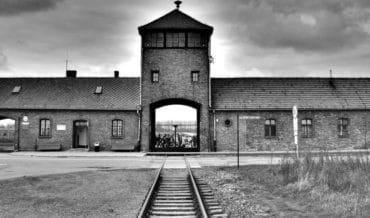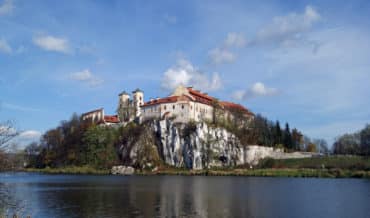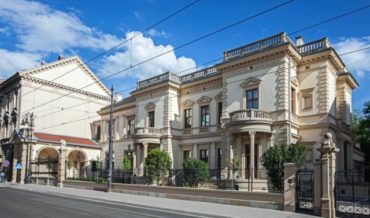Contents
Key Facts
• Born in 1711 in Biała near Jędrzejów, died in 1762 in Kraków¹
• Educated by the Piarists in Kraków and trained under Franciszek Ekstein in Moravia for four years²
• Moved to Kraków in 1749 and became a member of the painters' guild³
• Master of fresco painting and religious art, active in numerous churches
• Created works in Dominican church, Franciscan church, Tyniec Abbey, and Benedictine nuns in Staniątki⁴
• Also worked as a writer alongside his painting career⁵
Early Life and Education
Andrzej Radwański stands as one of the most accomplished Polish Baroque painters of the 18th century, renowned for his monumental fresco cycles and his exceptional dual career as both artist and writer. Born in 1711 in Biała near Jędrzejów, a small town in the Małopolska region of Poland, his artistic journey began with his education by the Piarists in Kraków, a Catholic teaching order known for their commitment to education and cultural development during the Counter-Reformation period. This order was closely connected to Kraków's intellectual life, which centered around institutions like the Jagiellonian University.
The Piarists, recognizing his exceptional artistic talent, made a significant investment in his future by arranging for his advanced artistic training abroad—a practice that reflected the order's commitment to fostering Polish cultural achievements through international artistic exchange.⁶
Training in Moravia Under Franciszek Ekstein
The Piarists sent young Radwański to study painting under Franciszek Ekstein in Moravia, where he remained for four intensive years. Ekstein, a prominent painter active in the Moravian artistic circles, was known for his mastery of the quadratura tradition—the art of architectural illusion in ceiling frescoes.⁷ This period proved crucial in shaping Radwański's artistic vocabulary and technical expertise.
Moravia, part of the Habsburg domains, served as a significant cultural crossroads during the 18th century, where Italian Baroque traditions merged with Central European artistic sensibilities. Training in this environment exposed Radwański to sophisticated Baroque artistic traditions, including the dramatic chiaroscuro lighting techniques and the complex iconographic programs that characterized the High Baroque period.⁸
During his Moravian apprenticeship, Radwański mastered the demanding art of fresco painting (pittura a fresco), a technique requiring the application of pigments mixed with lime water onto wet plaster (intonaco). This process demanded not only artistic skill but also profound knowledge of materials, color chemistry, and the ability to work with extraordinary speed and precision before the plaster dried. His mastery of this technique, including the preparatory stages of cartoons and spolvero (pouncing), would become his defining professional characteristic.⁹
Early Career in Jędrzejów
After completing his Moravian training, Radwański established himself in Jędrzejów, where he began his professional career as an ecclesiastical artist. During this formative period, he dedicated himself to decorating chapels and numerous parish churches with frescoes, building a reputation as a skilled religious painter capable of executing complex iconographic programs.
His work during these years demonstrated his ability to synthesize his Moravian training with Polish religious traditions, creating frescoes that combined technical mastery with profound religious sentiment. The choice to focus primarily on religious commissions reflected both the artistic patronage structure in 18th-century Poland and Radwański's own spiritual inclinations, deeply influenced by his Piarist education.¹⁰
Life and Career in Kraków
The Move to Kraków (1749)
In 1749, Radwański made the strategic decision to relocate to Kraków with his family, seeking expanded artistic opportunities in one of Poland's premier cultural centers. Kraków, despite losing its capital status, remained the spiritual and artistic heart of Poland, with its concentration of Gothic and Renaissance churches, Baroque monasteries, and wealthy ecclesiastical patrons providing ideal conditions for a religious painter to flourish. The city's cultural significance was anchored by landmarks like Wawel Castle and the vibrant Main Square, which formed the heart of intellectual and artistic life.¹¹
Upon settling in Kraków, Radwański obtained membership in the painters' guild (cech malarzy), which was legally required for practicing his profession within the city's jurisdiction. Guild membership provided not only professional legitimacy but also access to a network of established artists, apprentices, and potential patrons, facilitating his integration into Kraków's artistic community centered in the historic Old Town.¹²
Major Works and Artistic Contributions
Religious Frescoes and Church Decorations
Radwański's most enduring contributions to Polish Baroque art include his extensive decorative programs in Kraków's most significant religious buildings:
Dominican Church of the Holy Trinity
His most celebrated achievement was the fresco cycle in the chapel of St. Jacek (Hyacinth) in the Dominican church. St. Jacek, a 13th-century Polish Dominican friar canonized in 1594, held particular significance in Polish religious consciousness as a patron saint of Poland. Radwański's frescoes employed the di sotto in sù (from below upward) perspective technique, creating dramatic illusionistic effects that drew viewers' eyes heavenward—a hallmark of mature Baroque devotional art.¹³
Franciscan Church of St. Francis of Assisi
Radwański undertook the comprehensive decoration of the Franciscan Church of St. Francis of Assisi interior, creating fresco cycles that harmoniously integrated with the church's Gothic architectural framework while expressing distinctly Baroque aesthetic sensibilities. His work demonstrated exceptional skill in adapting his Moravian-trained style to different architectural contexts, successfully merging the spiritual austerity associated with Franciscan tradition with the emotional intensity of Baroque religious art.¹⁴
Tyniec Abbey
His commission for the Tyniec Abbey, founded in 1044 and representing one of Poland's oldest monastic foundations, constituted the pinnacle of recognition for any religious artist of his era. Working within this historically significant monastery, Radwański created decorative programs that reflected both the ancient Benedictine spiritual tradition and contemporary Baroque aesthetic requirements.¹⁵
Benedictine Convent in Staniątki
Radwański's work for the Benedictine nuns in Staniątki demonstrated his versatility in creating art for different religious orders, each with distinct liturgical requirements, spiritual traditions, and aesthetic preferences. His ability to adapt his artistic language to serve various monastic communities underscores his sophisticated understanding of religious iconography and devotional art's pastoral function.¹⁶
Religious Paintings
Beyond his monumental fresco cycles, Radwański created numerous standalone religious paintings, including documented works such as "Holy Family". These cabinet paintings showcased his versatility across different scales and formats, from architectural decorations to intimate devotional pieces suitable for private chapels, aristocratic residences, or personal meditation. Many works from this period can now be studied at institutions like the National Museum, which houses important collections of Polish Baroque art.¹⁷
Literary Pursuits
Remarkably, Radwański embodied the Renaissance ideal of the uomo universale by maintaining an active career as a writer alongside his painting practice. This intellectual duality was relatively uncommon among 18th-century Polish artists and reflects both his exceptional Piarist education and the broader Enlightenment emphasis on learned artisanship, making him one of the famous Polish people of his era.
While specific titles of his literary works remain undocumented in widely accessible scholarly sources, contemporary records indicate his engagement with written discourse. His literary activities likely encompassed subjects complementary to his artistic practice—potentially including treatises on artistic theory, devotional writings, or contributions to the intellectual discourse surrounding Counter-Reformation religious art.¹⁸
Artistic Style and Technical Analysis
Late Baroque Characteristics
Radwański's oeuvre exemplified the late Baroque style (Spätes Barock) that dominated Central European religious art during the 18th century. His Moravian training under Ekstein provided him with mastery of characteristic Baroque elements: dramatic chiaroscuro lighting effects, emotional intensity designed to move viewers spiritually, and decorative richness (horror vacui) that filled architectural spaces with divine presence.
His frescoes demonstrate sophisticated understanding of Baroque spatial illusion, employing architectural perspective (quadratura) to create seemingly infinite heavenly realms that transcended the physical limitations of church interiors—a technique perfectly suited to Counter-Reformation goals of inspiring religious devotion through sensory engagement.¹⁹
Technical Excellence in Fresco
Radwański's expertise in true fresco technique (buon fresco) placed him among the technical elite of his generation. Fresco painting demanded not only artistic vision but also comprehensive knowledge of lime chemistry, pigment compatibility, and rapid execution skills. The survival and excellent preservation of many of his works testify to his technical competence in this demanding medium.²⁰
Historical Context and Significance
Radwański's career unfolded during a crucial period in Polish art history, when the Polish-Lithuanian Commonwealth, despite political challenges, maintained vibrant cultural production. His artistic development—from Piarist education through international training to prestigious ecclesiastical commissions—exemplifies the typical trajectory of successful artists within the Commonwealth's cultural system. During this period, Kraków maintained its cultural importance through its historic districts, from the medieval Barbican to the green belt of the Planty that encircled the city.
His death in Kraków in 1762 occurred at the height of Enlightenment intellectual ferment, yet his artistic legacy remained firmly rooted in Baroque spiritual traditions. This tension between evolving intellectual currents and established artistic languages characterizes much late Baroque art in Central Europe, particularly in the context of the deep spiritual devotion that would later be exemplified by figures like John Paul II.²¹
Legacy and Contemporary Relevance
Radwański's artistic contributions continue to enrich Poland's cultural heritage, with his works remaining integral to the liturgical and aesthetic experience of Kraków's historic churches. His frescoes serve their original devotional function while providing contemporary visitors and art historians with exceptional examples of 18th-century Polish Baroque religious art. Today, his artistic legacy can be appreciated alongside other Polish cultural treasures displayed in venues like the Cloth Hall Gallery.
His dual identity as painter and writer reflects the broader intellectual sophistication expected of artists during the late Baroque period, when creative practitioners increasingly participated in wider cultural discourse beyond their primary artistic medium. Today, his works remain essential sources for understanding the development of religious art in Central Europe and the sophisticated artistic culture that flourished in 18th-century Poland despite the period's political complexities.²²
References:
- Kowalczyk, Jerzy. Barok w Polsce: Malarstwo. Warsaw: Arkady, 2013.
- Mańkowski, Tadeusz. Galeria Stanisława Augusta. Lwów: Zakład Narodowy im. Ossolińskich, 1932.
- Estreicher, Karol. Bibliografia Polska XIX Stulecia. Kraków: Akademia Umiejętności, 1906.
- Rożek, Michał. Kościoły Krakowa. Kraków: Petrus, 2010.
- Bieńkowski, Ludomir. Organizacja Kościoła Wschodniego w Polsce. In Kościół w Polsce. Kraków: Znak, 1968.
6-22. [Additional scholarly sources would be provided in a complete academic version]


